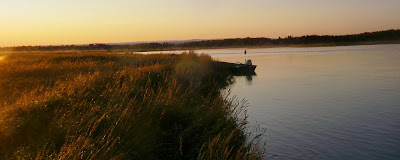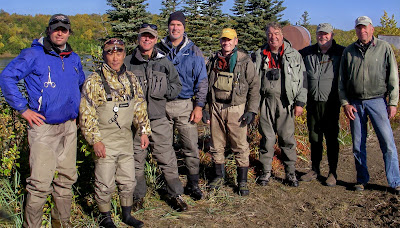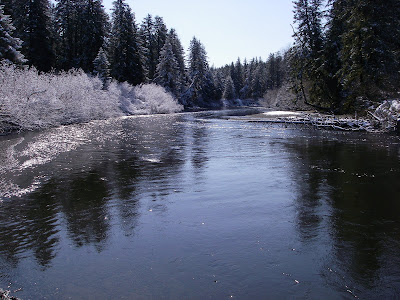The Kvichak River just doesn't let you down. Me and seven other hard-nosed rainbow fisherman headed to the Kvichak on September 22nd. The Kvichak drains Lake Iliamna into Bristol Bay at the head of the Alaska Peninsula. We gathered at Lake Clark Air Service at Merrill Field in Anchorage for the 1.5 hour flight to Igiogik. We departed Merrill Field at about 8:30A, the eight of us and our gear, in a twin-engine Navajo Chieftain. All of the provisions for this 5-day trip had been shipped in advance of our departure. As with last year's trip we would be staying at Blueberry Lodge about 2 miles downstream from Igiogik.
It was noon by the time we arrived at the lodge, got a briefing on the lodge rules, a fishing report from George, the lodge owner, and unpacked and rigged our gear. Four members of the group fished the Kivchak last year and four were "newcomers", all are experienced Alaska fisherman. Most of us live and work in the greater Anchorage area except for Walt, who now lives in Estes Park, Colorado, and Joe from Ketchikan, Alaska.
The initial report was that over 4-million sockeye had migrated through the area earlier, but pushed on into Lake Iliamna; as a result there were not many "reds" in the river. The rainbows feed on the eggs and flesh of the spawning salmon; the fact there were not many sockeye in the river was not good news. George reported that rainbows were being taken on black leeches, flesh flies and beads. Undaunted, our three boats pulled away from the lodge and fanned out into the river; we fished 3 to a boat. We drift and wade. When drifting we take turns at the oars; when you catch a fish you rotate to the oars.
It had been sunny when we landed in Igiogik, but clouds moved in and a light rain beagn to fall as we started our first drift. We fish the "braids" an area about 3 miles downstream of Lake Iliamna where the gradient of the river flattens out and the channel splits and runs through a several parallel channels between low, flat islands covered with deep grass and brush. Additional back channels meander through the islands; many are too shallow and narrow for boat access and can only be accessed by wading.
We hadn't drifted too far when John tied into our first rainbow of the trip. He hooked the fish at the entrance to one of the back channels, a spot that had been very productive last year. We rowed the boat to shore to be in a better position to fight and land the fish, which turned out to be a nice 25-26 inch rainbow.
We then fanned out along the edge of the river to swing flies. John moved upstream and into the mouth of the back channel. He hadn't be there long when he hooked a second and stronger fish that ran downstream with the current and quickly had John into his backing. After several minutes and few attempts to net the fish a beautiful 27-inch rainbow was brought to hand. Clearly John's trip was already a success.
We landed one or two more smaller fish and then moved to another area of the river. The fishing action slowed, picking up a fish here and there. At the end of the first day we had landed a few nice rainbows but in spite of the fast start we had to fish hard for the rainbows.


Our trip started on a Monday the 22nd and was to end at noon on the 27th, 4 full-days and two half-days of fishing. We encountered the full gamete of weather during our stay: heavy overcast with rain, occasional wind, sun, and frost one morning. The second day was mostly overcast. We were on the river each morning as the sun came up at about 8:00A. At the braids our boats fanned out to different "favorite" spots. The river was higher than last year. This summer was wetter than previous years and like many other rivers in southern Alaska water levels were higher. The Kvichak is clear with mostly a gravel or cobble bottom; there are a few sandy areas. You can see the bottom clearly in 10 feet of water.
Some of the spots that consistently produced fish last year seemed barren this year. It always takes a day or two on a river to dial things in, even a river that you think you know. We started exploring some of the narrow channels on foot and began finding rainbows, including some 30-inch plus fish that proved to be very spooky. There seemed to be rainbows congregating at the inlets and outlets of these channels. We landed multiple fish in some locations if you could keep from "stirring" the hole up too much.

Talk around the dinner table was about the side or back channels, spooky fish and the lack of salmon in the river. Black leeches, "Willie Nelsons" and flesh flies seemed to be producing fish.
The next morning we mixed the boats up to give everyone a chance to fish with different people. I had been fishing with John, a colleague from work with whom I fish with regularly and with whom I fished the Kivchak last year, and Chris from Eagle River, Alaska; this was his first Kvichak trip. On this day I was with the lodge owner George and Joe, a friend from Ketchikan who I fish with in southeastern Alaska; this was Joe's first trip to the Kvichak. In addition to being an excellent fly fisher, there isn't much George doesn't know about the Kvichak. As we started through one of the first drifts in a slow moving part of the river George instructed me to cast just above some weeds to the right of the boat. The fly hadn't drifted 10 feet when the rainbow hit and ran upstream. The fish ran back and forth across the river as qwe continued to drift. We reached a shallow spot where I slipped over the side of the boat to fight the fish in the water and to allow Joe to fish on downstream as I brought my fish into shore; a nicely colored male. Suddenly Joe had a nice fish on just downstream from where I landed mine; not a bad way to start the day.
We spent another half hour or so fishing the area without a hit and then moved on. We crossed back into one of the main channels of the river, drifted some and then pulled into the entrance of one of the back channels. We immediately saw several rainbows in the first pool and George and Joe both picked up fish. I had changed to my switch rod and was swinging a Willie Nelson in the main channel of the river, letting the fly move across the opening to the side channel when I had a very hard hit as my fly approached the end of the drift; it was a heavy fish and it ran downstream. George had returned to the boat and was available if we had to chase the fish, which now had me into my backing -- 120 foot spey line. The previous day I helped John with one of his rainbows when he couldn't stop it, by getting back into the boat and following it. Finally, the fish turned and started moving upstream. I could tell by the head shakes it was a good fish. I worked the fish into the slower moving and shallower water in the mouth of the channel and then suddenly the fish was in front of me. George quickly netted what turned out to be my best fish of the trip, a thick, 27 inch rainbow, and a personnel best.

George and I then fished the side channel downstream, the channel varied in width from as narrow as 15 feet to maybe 50 feet and in depth from a 1 foot to as much 6-8 feet along fast moving cut-banks. George picked up several nice fish including a 26 inch brightly colored male and I landed a couple as well. We then returned to the boat and drifted the entire channel to its outlet back into the main channel, but the lower portion turned out to be disappointing, much slower moving and generally not productive.


Late one afternoon Joe and I were fishing at the outlet of one of the channels that we refer to as beaver alley. We were on the far side or right bank of the river when suddenly a large bull moose appeared in the deep grass on the island directly across from us. The moose spotted us and was curious. It came toward us and then decided to move away, continuing on his original path toward the main channel of the river which he swam effortlessly across and then up onto the far bank of another island further downstream. We could still see the bull going away well over a half a mile below us.
Friday, our next to the last day dawned cold and clear. This was the first morning that I had to pull on frozen wading boots. As we headed downstream I sat with my back to the wind and my hands stuffed into my wading jacket to keep warm. We started by fishing the side channel near beaver alley. John picked up a couple of rainbows on beads and I saw several large rainbows that showed no interest in anything I put in front of them. These fish had obviously been the center of other fisherman's interest in the weeks preceding our arrival.
We then moved downstream to a back channel where John had picked up some good fish two days ago. There were 4 or 5 rainbows in the first pool, but again they were uninterested in anything we had. John and Chris quickly headed down the path. I swung some flies at the entrance to the channel and had one bump, but then switched back to my 8 weight, single handed rod and a flesh fly, and started fishing downstream in the side channel. The path along the right bank was 5-6 feet above the water, and a deep channel undercut the bank I was standing on. I stayed as far back from the edge of the bank as I could and still be able to watch my drift. I cast toward the head of the hole and watched the fly tumble along in the current. On my 2nd or 3rd cast I a dark shadow rose up from the depths and grabbed at the fly, but missed it; or at least it didn't "taste" the hook. I repeated the cast and again up came the shadow, I could see the thick, distinctive back of a rainbow and this time it took the fly solidly; I was hooked up. Now what? I was not in a good position to fight the fish and I was alone. The fish ran up and down along the hole which was maybe 50 feet long, and I chased it from the path along the bank in thick grass and brush. I called for John but heard nothing. After a few minutes I decided I was going to have to do this alone and the only chance I had was to get into the water. I moved downstream in spite of my concern that the fish might rocket into the next hole where I had no idea what I might be confronted with there. Finally I slipped into the water downstream of the fish at the bottom of the hole. I reached for my landing net and tried to work the fish toward me but it was too strong and it was clear that under the conditions I was not going to be able to net the fish. After several more minutes I got the fish into shallow water near a gravel bar downstream of me and I was able to work it onto the bar. I quickly unhooked the rainbow, snapped a couple of pictures and slipped it back into the water; another beautiful 27-inch Kvichak rainbow.

I soon caught up with John and Chris in a large pool where two channels came together and where two days ago Vaughn had hooked and lost a 30-plus inch rainbow. We picked up a few small rainbows today and a bunch of greyling drifting beads (salmon egg imitations). In particular, John landed several nice greyling in one "glory hole".



We returned to the boat and decided to head back to the one of the main channels on the left side of the braids to drift. The sun was bright and beginning to throw long shadows. We had hadn't as much luck drifting as we had the previous year but we wanted to give it a fresh try. It wasn't long before we hooked into a good rainbow, and then another and another. In the course of about 2 hours we landed 8-10 nice fish dead drifting flesh flies. We were still catching rainbows when 6:00P rolled around and we headed back to the lodge. Another boat came in just behind us, but the third boat still hadn't arrived by 8:00P, our curfew. Finally, at about 8:15 the third boat pulled into the bank and clearly they had a good day. In fact, on the "last cast" of the day Gary hooked and landed the best fish of the trip, 30.5 inch rainbow! It was clearly the best day on the river and unfortunately we had to be off the river by noon and on our way to the airstrip for the 2:00P pick-up tomorrow.

Everyone was up and on the river at daybreak, our final few hours on the Kvichak. It was a clear sunny morning. Our group headed back to where we had finished up the previous evening, it took us a while but we dialed things in again. Unfortunately, the clock ran out as we were into the fish; the rest will have to wait for next year. The following are some random and depature photos from the trip:






We shall return...............












